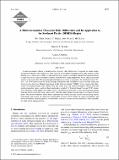| dc.contributor.author | Gille, Sarah T. | |
| dc.contributor.author | McClean, Julie L. | |
| dc.contributor.author | Griesel, Alexa | |
| dc.contributor.author | Flierl, Glenn Richard | |
| dc.contributor.author | Chen, Ru, Ph. D. Massachusetts Institute of Technology | |
| dc.date.accessioned | 2016-02-05T12:15:40Z | |
| dc.date.available | 2016-02-05T12:15:40Z | |
| dc.date.issued | 2015-07 | |
| dc.date.submitted | 2015-04 | |
| dc.identifier.issn | 0022-3670 | |
| dc.identifier.issn | 1520-0485 | |
| dc.identifier.uri | http://hdl.handle.net/1721.1/101107 | |
| dc.description.abstract | A multiwavenumber theory is formulated to represent eddy diffusivities. It expands on earlier single-wavenumber theories and includes the wide range of wavenumbers encompassed in eddy motions. In the limiting case in which ocean eddies are only composed of a single wavenumber, the multiwavenumber theory is equivalent to the single-wavenumber theory and both show mixing suppression by the eddy propagation relative to the mean flow. The multiwavenumber theory was tested in a region of the Southern Ocean (70°–45°S, 110°–20°W) that covers the Drake Passage and includes the tracer/float release locations during the Diapycnal and Isopycnal Mixing Experiment in the Southern Ocean (DIMES). Cross-stream eddy diffusivities and mixing lengths were estimated in this region from the single-wavenumber theory, from the multiwavenumber theory, and from floats deployed in a global k[subscript 0]° Parallel Ocean Program (POP) simulation. Compared to the single-wavenumber theory, the horizontal structures of cross-stream mixing lengths from the multiwavenumber theory agree better with the simulated float-based estimates at almost all depth levels. The multiwavenumber theory better represents the vertical structure of cross-stream mixing lengths both inside and outside the Antarctica Circumpolar Current (ACC). Both the single-wavenumber and multiwavenumber theories represent the horizontal structures of cross-stream diffusivities, which resemble the eddy kinetic energy patterns. | en_US |
| dc.language.iso | en_US | |
| dc.publisher | American Meteorological Society | en_US |
| dc.relation.isversionof | http://dx.doi.org/10.1175/JPO-D-14-0229.1 | en_US |
| dc.rights | Article is made available in accordance with the publisher's policy and may be subject to US copyright law. Please refer to the publisher's site for terms of use. | en_US |
| dc.source | American Meteorological Society | en_US |
| dc.title | A Multiwavenumber Theory for Eddy Diffusivities and Its Application to the Southeast Pacific (DIMES) Region | en_US |
| dc.type | Article | en_US |
| dc.identifier.citation | Chen, Ru, Sarah T. Gille, Julie L. McClean, Glenn R. Flierl, and Alexa Griesel. “A Multiwavenumber Theory for Eddy Diffusivities and Its Application to the Southeast Pacific (DIMES) Region.” Journal of Physical Oceanography 45, no. 7 (July 2015): 1877–1896. © 2015 American Meteorological Society | en_US |
| dc.contributor.department | Massachusetts Institute of Technology. Department of Earth, Atmospheric, and Planetary Sciences | en_US |
| dc.contributor.mitauthor | Flierl, Glenn Richard | en_US |
| dc.relation.journal | Journal of Physical Oceanography | en_US |
| dc.eprint.version | Final published version | en_US |
| dc.type.uri | http://purl.org/eprint/type/JournalArticle | en_US |
| eprint.status | http://purl.org/eprint/status/PeerReviewed | en_US |
| dspace.orderedauthors | Chen, Ru; Gille, Sarah T.; McClean, Julie L.; Flierl, Glenn R.; Griesel, Alexa | en_US |
| dc.identifier.orcid | https://orcid.org/0000-0003-3589-5249 | |
| mit.license | PUBLISHER_POLICY | en_US |
